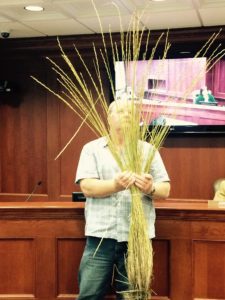This morning, day eight of the South Dakota Keystone XL pipeline hearings, Dakota Rural Action member Sue Sibson took the stand.
The Sibsons, husband and wife Mike and Sue, live out near Howard. They’re a good, third-generation South Dakota ranch family; they grow crops and run cattle out on their land. Grass-fed, high-quality beef. The kind of beef from cows run on good grass.
TransCanada first wandered into the Sibson’s lives on June 24, 2006. A land agent said a pipeline company wanted to put a pump station on their land, and offered them $25,000. Mike’s response? “I’ll give you $25,000 to get it off my land.”
Their meeting was the start of a nine-year saga between the Sibsons and TransCanada. Shortly after the first land agent came around, another knocked on their door, this time with an easement in hand. The Sibsons looked it over, and had some serious concerns. First, the proposed route crossed their native grass, wetlands, and waterways. Second, the easement seemed quite lopsided in favor of TransCanada; it waived all liability of the company, and it was written to allow “one or more” pipelines, not just one.
The Sibsons, feeling the pressure from TransCanada, joined with 30 other landowners to collectively come up with an easement. The 30 landowners signed, knowing farmers further north on the route had already been served papers to take their land. As she testified this morning, talking about the moment they had to sign the easement, Sue paused. On the verge of tears, Sue told the Commission, “Signing the easement was the hardest thing Mike and I have ever had to do in our lives.”
But signing the easement wasn’t the end of the story for the Sibsons. After they signed, TransCanada’s contractors moved in to start construction, and started leaving trash laying around. In September, the Sibsons recorded 1.3 inches of rainfall. And to their great surprise, there was the construction crew – out in the mud, slopping their land around, building the pipeline! The permit granted by the Public Utilities Commission for Keystone I requires the company suspend construction when weather conditions will result in irreparable damage, but construction continued nonetheless.

According to the Sibsons, the areas where construction occurred in these conditions still show the damage. “They were in a hurry to do the reclamation,” Sue said. They quickly drove the re-seeder over the land in wind going 30 miles per hour. The grass that was supposed to grow never came up.
Instead, the Sibsons ended up with this all over the easement area:

TransCanada has been back five times attempting to reclaim the Sibson’s land, to little success. This may be in part due to twice having tried to re-seed in the fall, which does not work. They have only come around to continue the reclamation work at the request of the Sibsons, and starting in 2013 TransCanada started asking the Sibsons to sign off on the reclamation, even though it is not done. They’ve asked twice now, and twice the Sibsons have told TransCanada they will not sign.
Toward the end of her time on the stand, Sue was asked how much time she has had to spend dealing with TransCanada since their first meeting in June in 2006. “I would estimate at least 3000 hours,” she said. Just under seven hours, every week, for going on ten years.
Dealing with TransCanada should not be a part time job for any South Dakota landowner, let alone those who feel – and who were – forced into easement agreements under threat of eminent domain. The burden is on TransCanada do to what is right. The Sibson’s experience shows the company incapable of doing so.
It’s time to reject the Keystone XL pipeline – we don’t need a 300-mile long scar across the western native grasslands of South Dakota.
